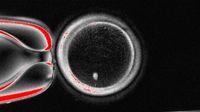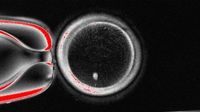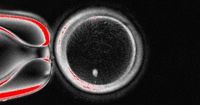In a groundbreaking development that could one day transform fertility medicine, scientists at Oregon Health & Science University (OHSU) have successfully created human eggs from adult skin cells in the laboratory. The research, published on September 30, 2025, in Nature Communications, marks a significant proof-of-concept for a technology that might eventually help infertile women and same-sex couples have genetically related children. However, the technique remains years away from clinical use due to persistent genetic hurdles and daunting ethical questions.
The OHSU team, led by Dr. Shoukhrat Mitalipov, director of the Center for Embryonic Cell and Gene Therapy, employed a method inspired by the cloning of Dolly the sheep in 1997. Rather than relying on the more common approach of converting adult cells into induced pluripotent stem (iPS) cells, the researchers opted for somatic cell nuclear transfer. This involved extracting most of the DNA from a healthy donor egg and replacing it with DNA from a skin cell taken from another person. The resulting egg, now carrying the genetic material of the skin cell donor, was then coaxed through a novel process dubbed “mitomeiosis.” This procedure was designed to mimic the natural reduction of chromosomes that occurs during the formation of eggs and sperm, ensuring that only one set of chromosomes remained.
The researchers produced 82 functional human oocytes, or immature egg cells. Next, these lab-generated eggs were fertilized with donated sperm in petri dishes. The results were cautiously promising: about 9% of the fertilized eggs survived for five to six days, developing to the blastocyst stage—the point at which embryos are typically transferred to the uterus during in vitro fertilization (IVF). As Dr. Mitalipov explained to NPR, “It’s a significant step forward.”
Yet, the breakthrough comes with a critical caveat. All embryos created in the study were chromosomally abnormal. According to Dr. Paula Amato, coauthor and professor of obstetrics and gynecology at OHSU, “All the resulting embryos were chromosomally abnormal, either because they had the wrong total number of chromosomes or not one from each pair.” These abnormalities, which stem from the challenges of correctly reducing chromosome numbers in the reconstituted eggs, mean that none of the embryos would be suitable for implantation or could result in healthy babies.
The research team stressed that their findings represent a proof-of-concept rather than a ready-to-use clinical technique. “We kind of developed this new cell division that can reduce chromosome number,” said Dr. Mitalipov, as reported by the Associated Press. “It’s still not good enough to make embryos or eggs genetically normal.” Both he and Dr. Amato emphasized that it could take a decade or more of further research before the method might be considered for human fertility treatments. The main focus now is to refine the chromosome reduction process and better understand how chromosomes pair and separate to create viable, healthy eggs.
This limitation has not dampened the enthusiasm of some in the scientific community. Dr. Sigal Klipstein, a reproductive endocrinologist with the American Society of Reproductive Medicine, described the study as “a very significant step in terms of moving forward to the ability to use skin cells to make egg cells for human reproduction at some point in the future, once we can prove this is safe and effective.” Similarly, Professor Ying Cheong of the University of Southampton called the work “an exciting proof of concept” and highlighted its potential to transform how infertility and miscarriage are understood and treated.
Others, however, urge caution. Professor Amander Clark of UCLA, who was not involved in the research, pointed out, “All the embryos were genetically abnormal. Therefore, this approach will not, and should not, be offered in the IVF lab until technical improvements are made.” She also noted the high regulatory barriers facing any clinical application of this technology, given its roots in cloning techniques and the ethical complexities involved.
The implications of in vitro gametogenesis (IVG)—the field of creating eggs and sperm from somatic cells—are enormous. For millions of women who cannot produce viable eggs due to age, medical treatments, or primary ovarian insufficiency, IVG could offer hope for a genetically related child. As Dr. Amato explained to CNN, “This would allow older women, or women without eggs for any reason (e.g. previous cancer treatment) to have a genetically related child. In addition, it would allow same-sex couples (two men for example) to have a child genetically related to both partners.”
But with such promise comes a host of ethical, social, and legal concerns. Bioethicists warn that the technology could open the door to so-called "designer babies," where parents might select for preferred traits such as intelligence, athleticism, or musical talent. Hank Greely, a bioethicist at Stanford University and author of The End of Sex and the Future of Human Reproduction, told NPR, “We could see more efforts to try to use it for so-called enhancement purposes—to try to get embryos that would be stronger or more athletic or more musical or better at math or more intelligent. Some people view that as a terrible prospect. Some people view that as a wonderful prospect.”
There are also concerns about privacy and consent. Ronald Green, a Dartmouth College bioethicist, warned of the theoretical possibility that someone could steal a skin cell from another person—perhaps a celebrity—and use it to create a baby without their knowledge or permission. “We could have Taylor Swift babies all over the world. It’s a theoretical possibility, but not crazy,” Green said.
Another possibility, though more speculative, is the creation of a "uni-baby," a child with genetic material from only one person. Greely mused, “Would anyone want to do that? Well, there are 8 billion people in the world and some of them have very strong egos and some are very rich. So I wouldn’t guarantee that no one would want to do that.”
Despite these concerns, many in the field believe the potential benefits of IVG warrant continued research, provided there is robust oversight and ethical scrutiny. As Greely put it, “If it was safe, it would offer relief to literally millions of people around the world who desperately want to have kids who are genetically theirs.”
For now, the OHSU team and their peers around the world are focused on overcoming the technical challenges—especially ensuring that lab-grown eggs have the correct number and arrangement of chromosomes. The journey from proof-of-concept to clinical reality is likely to be long, complex, and closely watched by scientists, ethicists, and the public alike. But the first step, it seems, has been taken.






